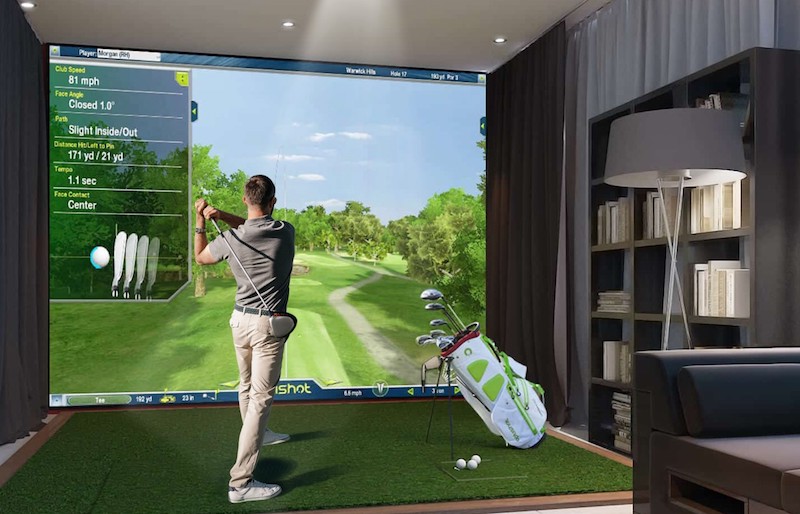According to the National Golf Foundation’s latest 2023 report, golf is a staggering $102 billion industry, surpassing even the revenue of the NFL and NASCAR. A significant portion of this success can be attributed to the increasing demand for golf simulation. Custom Market Insights (CMI) reports that the global golf simulators market size was estimated at $1.3 billion in 2021 and is projected to reach around $3.4 billion by 2030.
Golf simulation offers an appealing indoor and weather-independent alternative to playing on a golf course. This technology has gained popularity among both golf pros and novices alike. During the pandemic, the demand for home systems skyrocketed as people sought entertainment options while staying indoors. This trend continues post-pandemic, with brick and mortar businesses installing golf simulators to attract patrons and boost revenue. News stories frequently feature new installations in various venues, including golf retail stores, bars, clubs, resorts, and offices.
Undoubtedly, golf simulators have firmly entered the mainstream. However, achieving a truly exceptional and high-quality golf sim experience requires careful consideration. In the past, golf simulators were limited to basic setups comprising just a computer and a golf game. These setups lacked the realism essential for capturing the essence of real golf and often felt disconnected from the sport itself. In contrast, modern golf simulators faithfully replicate the natural golf environment by incorporating vital components like a monitor, impact screen, computer and golf sim software, turf, and projector.
The cornerstone of an authentic golf simulator experience lies in the projector. Its ability to faithfully replicate every intricate detail becomes paramount, from the subtle shades of green on the grass to the gentle ripples of water. Moreover, it must possess sufficient brightness to deliver quality visuals even with ambient lighting. Not all projectors can meet these demanding requirements for quality, color accuracy, and brightness. The best projectors boast an impressive 90% color reproduction visible to the human eye, ensuring a near-perfect color presentation that is essential for an immersive, lifelike, and enjoyable golf simulator experience.
My company, BenQ, has designed a 3,600-lumen LH820ST Full HD short-throw laser golf sim projector that we believe meets the standard for realistic golf simulation. Through a collaboration with color experts, we developed an exclusive Golf Mode that optimizes the colors of the blue sky and green grass, creating a captivating and immersive experience for golfers. Additionally, the projector features a dual color wheel system, covering 90% of Rec.709, the industry-wide standard for color reproduction in HD video and movies. This ensures that viewers, whether using it for golf, movies, or games, are treated to perfect colors, precisely as intended by the director.
When setting up a golf simulation space, a short throw projector emerges as the indispensable solution, allowing precise placement outside the hitting area while eliminating shadows. Its versatility enables fitting the system into virtually any space, and a prime example is the LH820ST with its 0.5 throw ratio, capable of projecting a 177″ image from just 7 feet away from the screen, providing a vast display without the need for costly optional lenses.
In most cases, the projector won’t align directly with the screen, which is crucial to avoid placing it within the swing radius of a club or the flight path of a ball. Fortunately, projectors equipped with digital image manipulation tools offer a solution by allowing easy centering of the image, even if the projector is not directly aligned with the screen. Features like 2D keystone correction, corner fit, horizontal, and vertical lens shift offer remarkable flexibility during installation, especially in tighter spaces.
Historically, projectors demanded a substantial investment beyond the initial purchase, burdening users with costly lamp replacements and filter maintenance. However, modern laser projectors have revolutionized the landscape, eliminating the need for filters and lamps, making them ideal for dust-prone environments like garages or basements. These laser projectors have become remarkably affordable and boast an impressive lifespan of 20,000 hours, providing years of seamless and reliable use.
The accessibility of golf simulation technology has increased, thanks to the drop in price points. Today, you can find a laser projector under $2,000 that doesn’t compromise on quality. This remarkable development in capability and affordability has made multi-purpose home entertainment spaces featuring golf simulators more attainable for businesses and homeowners alike.
Golf simulation technology has become a driving force in the golf industry’s massive $102 billion revenue. As the global golf simulators market size continues to grow, the accessibility and convenience of indoor, weather-independent golf experiences have attracted players of all skill levels, from novices to seasoned professionals. During the pandemic, the demand for home systems skyrocketed, and post-pandemic, brick and mortar businesses also embraced golf simulators to enhance entertainment and revenue.
Crucial to a high-quality golf sim experience is the projector optimized for golf and able to deliver great color accuracy. With the price point of laser projectors coming down, more businesses and homes can now afford these advanced simulation setups, contributing further to golf simulation’s mainstream appeal and its impact on the golf industry as a whole.






![ecobee premium airzone control The ecobee Smart Thermostat Premium. [Photo credit | ecobee]](https://restechtoday.com/wp-content/uploads/2025/06/ecobee-premium.jpg)
![Hub 3_02 The SwitchBot Hub 3 provides a user-friendly solution to the growing complexity of modern smart homes. [Photo credit | SwitchBot]](https://restechtoday.com/wp-content/uploads/2025/06/Hub-3_02-scaled-e1750179791687.png)
